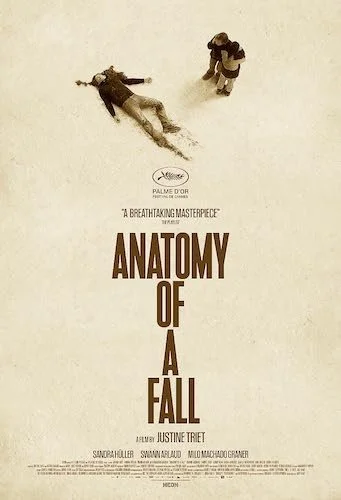Anatomy of a Fall
Written by Andreas Babiolakis
This review is a part of the Palme d’Or Project: a review of every single Palme d’Or winner at Cannes Film Festival. Anatomy of a Fall won the sixty seventh Palme d’Or at the 2023 festival.
The film was selected by the following jury.
Jury President: Ruben Östlund
Jury: Paul Dano, Julia Ducournau, Brie Larson, Denis Ménochet, Rungano Nyoni, Atiq Rahimi, Damián Szifrón, Maryam Touzani.
Warning: The following review is a part of TIFF 2023 and may contain spoilers for Anatomy of a Fall. Reader discretion is advised.
What is our fascination with true crime? Is it the possibility that an everyday person can be culpable of hideous actions? Such is the curiosity found in the core of Justine Triet’s Palme d’Or winning feature film Anatomy of a Fall: a legal drama fable that forces you to be a part of the dissection. It works via two parts: the introduction to the scenario, and the analyses of every piece of evidence as they get stacked on top of one another. The buildup is something special, with little cues that keep you invested right from the get-go. The very first image we see is of a ball bouncing on some steps as it heads downstairs, and it’s clear that it is at least a symbol of the descent into a case we are about to experience (we know what we are in for right away, and the title of the film partially alludes to our protagonist’s fall-from-grace during her time of grief). This protagonist is Sandra, played appropriately by Sandra Hüller in an award-worthy performance. She is an author who begins the film at the start of a journalist’s interview. With the way the sound is recorded, it almost sounds like a podcast and while that isn’t the intention, Triet does want you to listen closely and experience as much of the film through sound as opposed to sight, as to understand the point of view of Sandra’s blind son Daniel.
Daniel’s perspective is crucial in Anatomy of a Fall because shortly after Sandra’s prematurely-aborted interview concludes (no thanks to husband Vincent blasting an instrumental version of 50 Cent’s “P.I.M.P.” as loudly as possible… yes, really), it is this very husband — and Daniel’s father — who is found dead with a spillage of blood out in the snow in front of their French home. There is no time to grieve as Anatomy of a Fall leaps right into the legal follow-up, with Sandra instantly being questioned by her lawyer-friend (so you know there isn’t an immediate bias against her, but perhaps there may be a bias towards her). This is helpful considering how swiftly the odds are stacked against Sandra, who is thought to be the lone suspect in Vincent’s death which is considered either a suicide or a case of spousal-related murder. Anatomy of a Fall sticks to its name once it begins to strip apart the titular accident (or crime) layer by layer, down to physical and digital reenactments of what may have happened alongside other revelatory pieces of information. This is precisely when I realized that the ball at the start of the film was more than an allegory: it acted as a replacement sequence for the fall itself, and you can imagine Vincent and his head matching with these now-haunting sounds. We see everything but the actual fall, but we can swear that we did witness it once the film is done because of all of the details provided to us.
Anatomy of a Fall gives exactly what you sign up for: a legal drama full of thrills and chills.
You’ll begin Anatomy of a Fall certain that Sandra is innocent, but she gets lambasted from all angles with questions you don’t know the answers to (and these will open up a series of cans of worms). Once Daniel is brought into questioning even before the trial takes place, clarity becomes even murkier. You yourself will feel stretched thin with where you stand in this trial, and that’s exactly how Anatomy of a Fall wants you to feel. Misinformation becomes evidence. Glances become telltale signs. Even some of Sandra’s writing gets brought into the courtroom, particularly a passage she lifted from her late husband’s own drafts: a character who can experience two realities, one where their existence is centred around an accidental death, and another where they aren’t connected to the death whatsoever. Telling.
Triet is so good at bringing in aesthetic choices to tell the bits of missing information that really sell the validity of Anatomy of a Fall. This includes the prescient use of camerawork where our gaze cuts to certain focal points via double-take or pan around like wandering eyes when needed. This cinematography climaxes during a pivotal moment where Daniel is forced to answer to two lawyers and we continuously pan between two empty spaces as Daniel sits squarely in the middle; we don’t see who is talking at any point, but we know how Daniel’s attention is shifting precisely when it shifts. With all of these little details, Anatomy of a Fall becomes a tremendous feature film even if you understand the ending as tidy. I think there’s something a bit more ominous with how Anatomy of a Fall resolves. Triet allows you to form your conclusion even though the film has its own version and it sells the idea that there sometimes just isn’t anything more to add post-trial: we may be used to these celebratory endings in films prior, but that isn’t how the judicial system works. We either endure the pain of guilt or the battle is over and we breathe in the void of finality. Anatomy of a Fall will leave you guessing, talking, and feeling a myriad of things long after the film is done. It is easily one of the better courtroom dramas of the twenty-first century because it understands what makes cases so juicy and impossible to ignore.
Andreas Babiolakis has a Masters degree in Film and Photography Preservation and Collections Management from Toronto Metropolitan University, as well as a Bachelors degree in Cinema Studies from York University. His favourite times of year are the Criterion Collection flash sales and the annual Toronto International Film Festival.







